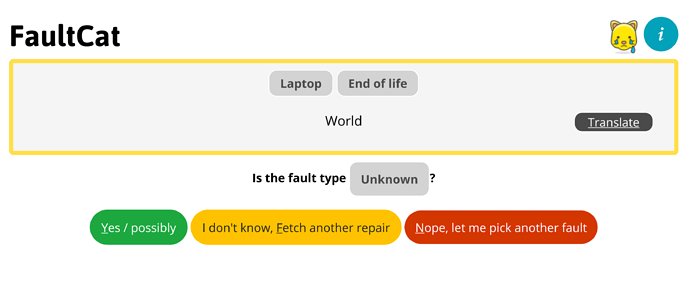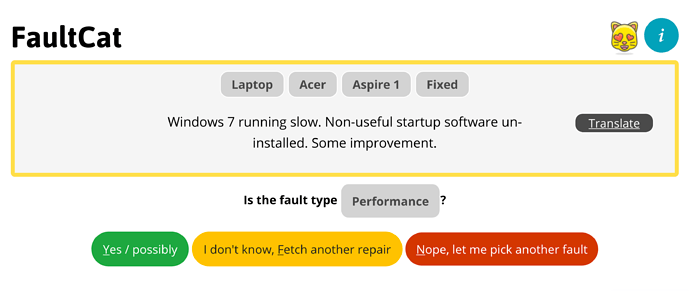This call has now ended, but for those who couldn’t make it (and those of us with short memories like myself!), here’s a summary of what we discussed:
 Who was in the room?
Who was in the room?
- @Nebojsa_Adzic - event organiser and data collector at Insertech (Montréal, Canada)
- @neil - Data & tech lead for Restart
- @Steve_Cook - repairer at Crystal Palace (London, UK) and all-round data whizz
- @Ten - Volunteer advocate for Restart
- @ugo - Restart co-founder
- @james (me)
 What did we talk about?
What did we talk about?
We wanted to explore ways to collect really detailed, useful information about the items seen at events. Given everyone in the room was already pretty keen on data, we skipped the conversation about why it’s important. But if we had talked about it, here’s what would probably have come up:
 Why does data matter?
Why does data matter?
How can repair data help your group?
- keep track of how your group is doing (see trends in the number of visitors, hours volunteered, items seen etc.)
- understand what items people are bringing to your events and how well you’re volunteers are doing with them (using fix rates to identify weaknesses and potentially offer training)
- measure your environmental impact (useful to motivate or recruit volunteers and even secure funding!)
How data helps the wider repair community:
- together, we demonstrate broader impact (both environmental and social) and show that we’re a global movement. This helps us tell bigger stories and…
- we can be more effective when pushing for Right to Repair (more data means better insights into how products can be made more repairable, which helps us make stronger arguments)
Some examples
 @ugo spoke about how Restart has been working with the Repair Café Foundation and others to bring together records of over 30,000 repair attempts, which we’re now using to inform work on the European Right to Repair campaign
@ugo spoke about how Restart has been working with the Repair Café Foundation and others to bring together records of over 30,000 repair attempts, which we’re now using to inform work on the European Right to Repair campaign
 Insertech in Canada has also submitted a paper on durable products to the Canadian government recently. @Nebojsa_Adzic said it would be very useful in future to be able to include insights from real repair data.
Insertech in Canada has also submitted a paper on durable products to the Canadian government recently. @Nebojsa_Adzic said it would be very useful in future to be able to include insights from real repair data.
 A note about data quality
A note about data quality
Sometimes, recording enough detail about each item during a repair event can be tough. So, one of the problems we see at the moment is poor quality data (repairs that are inaccurate or lack detail). Repairs without enough information aren’t that useful.
Here’s an example from our recent FaultCat experiment, where we’re trying to categorise the faults recorded for computers:
A tale of 2 laptops
Let’s look at two real laptops seen at events. If you’re trying to understand what the problem was and how it was fixed, it’s pretty easy to tell which description is more useful:
-
Laptop 
Here, we don’t know what the brand or model of laptop was, or even what the problem was:
-
Laptop 
Here we know the brand and model of laptop, what the problem was and how it was fixed:
 What’s the best way to record repair data at events?
What’s the best way to record repair data at events?
We took a dive into the advantages and disadvantages of different ways to record repair data at events.
 If you record data at your events, we’d love to hear how you do it. What works well and what are the biggest challenges? Do you use any of the ideas below?
If you record data at your events, we’d love to hear how you do it. What works well and what are the biggest challenges? Do you use any of the ideas below?
Use a flipchart
@Nebojsa_Adzic (Neb) uses a flipchart or whiteboard to record items that come into events, just like most Restarters groups. The flipchart or whiteboard also serves as a public queuing system and helps everyone get an idea of what’s going on at the event. Neb then takes a picture of the whiteboard at the end and adds the data to the Fixometer manually afterwards.
Use paper forms
@Steve_Cook has recently starting experimenting with paper forms in addition to having a flipchart. This is something @steve.cousens talked about in the last community call. Using a paper slip that follows the item around the event have improved the accuracy and detail of data recorded over the flipchart in the last couple of events. Steve said that the advantage of having a slip of paper is that it hasn’t required much explanation and it can be coupled with flyer/info about event that visitors can read. Because the visitor and repairer can fill in form together, the volume and accuracy of data recording has improved without doing much else and it gives everyone a task. Given most events have one entrance/exit and many items need to PAT testing, these touch points are good places to hand out and take back forms.
Thinking about the key question: ‘can we increase data capture by involving people who aren’t actively involved already?’, we talked about whether paper forms could offer the opportunity to tell the wider story of why we repair - an educational tool for participants.
But we also discussed some potential disadvantages to using paper forms. Neb told us about working with a repair café that used paper forms, but finding that some forms went missing (e.g. some people lost them or went home with them), that they caused confusion for some people and had to be explained.
Use a digital tool (live data entry)
@ugo has tried live data entry before, but found that typing on tablet was not ideal. @james had tried too and found it easier on a laptop, but everyone agreed that while live data entry is in many ways the ideal solution, it’s currently not easy enough.
Building a tool for live data entry?
When discussing how our own data entry tool here on Restarters.net (called the Fixometer), @Nebojsa_Adzic suggested that a proper mobile version that also helps with event management would make everything much easier.
This new tool could contain a gauge of some kind that goes up as devices are entered - something visual to represent progress and get people interested in the wider impact of the event.
It could also be used to register visitors to the event (e.g. recording their first names) and manage the queue of people waiting for a repairer to be free. This personal data wouldn’t have to be sent to the Fixometer.
@ugo shared that there is a group in Belgium currently developing a mobile app to allow for live recording of repairs. But that they’ve made the decision not to record any personal data about visitors or volunteers for data protection reasons.
Capture the stories behind repairs
@Steve_Cook suggested there’s lots of value in telling some of the amazing stories we hear about items brought to our events; the history of that particular item, the person who brought it in their relationship. Stories are a powerful to make repair events more relatable, so can be useful for publicity and explaining the idea to people who are new to concept.
There isn’t a standard way to do this yet, but sharing over social media can be effective.
Recruit a dedicated data volunteer
@neil was interested in the idea of having a volunteer dedicated specifically to recording repair data, something @Rosemary mentioned too in the previous community call. Some of us shared our own experiences of doing this in practice. We talked about it sometimes feeling a bit overwhelming for the data volunteer to keep track of every item at a busy event, especially when having to speak to repairers to follow each repair. Although, having a clear entry and exit point can help.
Learn from groups who do this well
@ugo suggested identifying groups that currently record good quality data and getting in touch to learn more about their process. Some of the groups we used as examples to follow were Leicester Fixers (thanks to @Divya_Pujara) and Farnham Repair Café
 Current challenges of entering data on the Fixometer
Current challenges of entering data on the Fixometer
@Nebojsa_Adzic shared that for him, having to input devices one by one after the event is most tiresome part of recording data, especially when entering it a long time after the event when it can be hard to remember details. Some kind of automatic upload that you can tweak would be more useful, as would a mobile interface to use during events themselves (see above).
@neil is working with a few groups on testing a new feature that allows groups to simply upload a spreadsheet to the Fixometer instead of adding individual items manually. @Nebojsa_Adzic and @Steve_Cook both expressed an interest in trying it out.
We also spoke about how explaining the importance of collecting good data is often a great way to motivate both volunteers and visitors to assist in the process…
 How to talk about the importance of collecting repair data
How to talk about the importance of collecting repair data
We spoke about many volunteers and visitors being highly motivated by the amazing social impact that community repair events can have, but sometimes less so by the benefits to the environment or repair activism.
With that in mind, we agreed that it’s important to offer volunteers and visitors opportunities to learn about how individual repairs benefit the environment and how they can contribute to larger work of pushing for Right to Repair legislation (as mentioned above).
@ugo mentioned that we’re looking to improve the way we capture data on Fixo and asked whether a document or video that explains data collection would be useful/interesting for people collecting data (in order to explain why we do it, and how we can do it better). We agreed that it would be.
This call has now finished. Thanks to everyone who came along!
![]()
 Why does repair data matter?
Why does repair data matter? What are the best ways to collect it at events?
What are the best ways to collect it at events?![]()
![]() If you use a desktop or laptop computer, it should work in most browsers without needing plugins.
If you use a desktop or laptop computer, it should work in most browsers without needing plugins.![]() If you’re on mobile, you’ll need to download the Jitsi Meet app for Android or iOS.
If you’re on mobile, you’ll need to download the Jitsi Meet app for Android or iOS.![]() If you struggle to connect, you can dial in from your phone using the instructions below:
If you struggle to connect, you can dial in from your phone using the instructions below:![]()
If you’d like a reminder on the day, let me know by replying below


